Renkus-Heinz ICC24/3 User manual
- Category
- Supplementary music equipment
- Type
- User manual
This manual is also suitable for

Digitally Steerable Line Array Loudspeaker Systems
Iconyx Compact Series
User’s Manual

2
IMPORTANT SAFETY INSTRUCTIONS
ICC12/3 and ICC24/3
1. Read these instructions.
2. Keep these instructions.
3. Heed all warnings.
4. Follow all instructions
5. Do not use this apparatus near water. The apparatus shall
not be exposed to dripping or splashing and no objects lled
with liquids, such as vases, shall be placed on it.
6. Clean only with dry cloth.
7. Do not block any ventilation openings. Install in accordance
with the manufacturer’s instructions.
8. Do not install near any heat sources such as radiators, heat
registers, stoves, or other apparatus (including ampliers)
that produce heat.
9. Do not defeat the safety purpose of the polarized or ground-
ing-type plug. A polarized plug has two blades with one
wider than the other. A grounding type plug has two blades
and a third grounding prong. The wide blade or the third
prong is provided for your safety. If the provided plug does
not t into your outlet, consult an electrician for replacement
of the obsolete outlet.
10. Protect the power cord from being walked on or pinched
particularly at plugs, convenience receptacles, and the point
where they exit from the apparatus.
11. Make sure the power cord remains readily accessible at all
times.
12. The AC Power Cord is the AC Mains disconnect.
13. Only use attachments/accessories specied by the manufac-
turer.
14. Disconnect this apparatus during lightning storms or when
unused for long periods of time.
15. Refer all servicing to qualied service personnel. Servicing
is required when the apparatus has been damaged in any
way, such as power-supply cord or plug is damaged, liquid
has been spilled or objects have fallen into the apparatus,
the apparatus has been exposed to rain or moisture, does not
operate normally, or has been dropped.
“WARNING - TO REDUCE THE RISK OF FIRE OR ELECTRIC
SHOCK, DO NOT EXPOSE THIS APPARATUS TO RAIN OR MOIS-
TURE”
“CAUTION: THESE SERVICING INSTRUCTIONS ARE FOR USE BY
QUALIFIED SERVICE PERSONNEL ONLY. TO REDUCE THE RISK
OF ELECTRIC SHOCK DO NOT PERFORM ANY SERVICING OTHER
THAN THAT CONTAINED IN THE OPERATING INSTRUCTIONS
UNLESS YOU ARE QUALIFIED TO DO SO”.
CAUTION
To reiterate the above warnings: servicing instructions are fo
r
use by qualified personnel only. To avoid electric shock, do
not perform any servicing other than that contained in the Ope-
ration Instructions unless you are qualified to do so. Refer all
servicing to qualified personnel.
Eindrigliche Warnung: Wartungsvorschriften dienen nur der
Benutzung durch qualifizieres Personal. Zur Vermeidung eines
elektrischen Schlages keine anderen als die in den Betriebsvor-
schriften beschriebenen Wartungsarbeiten ausführen, es sei denn
Sie sind dafür qualifiziert. Wartungsarbeiten auszuführen.
The lightning flash with arrowhead symbol,
within an equilateral triangle, is intended to
alert the use to the presence of uninsulated
"Dangerous Voltage" within the product's en-
closure that may be of sufficient magnitude
to constitute a risk of electric shock to hu-
mans.
The exclamanation point, within an equilateral
presence of important operating and mainte-
nance (servicing) instructions in the literature
accompanying the product.
VORSICHT
RISK OF ELECTRONIC SHOCK:
OPEN ONLY IF QUALIFIED AS
SERVICE PERSONNEL
GEFAHR EINES ELEKTRISCHEN SCHLAGES:
NUR VON QUALIFIZIEREM WARTUNGSPERSONAL
ZU ÖFFNEN
Der Blitz mit nach untenzielendem Pfeil in
einem gleichseitigen Dreieck weist den
Benutzer auf das Vorhandensein einer
unisolierten, "gefährlichen Spannung" im
Gehäuse hin, die stark genug sein kann, einer
Person einen gefährlichen elektrischen Schlag
zu versetzen.
Das Ausrufezeichen in einem gleichseitigen
Dreieck weist den Benutzer auf wichtige
Betriebs- und Wartungsvorschriften in den
beiliegenden Unterlagen des Gerätes hin.
Erklärung der graphischen SymboleExplanation of Graphical Symbols
IMPORTANT
Your Iconyx Steerable Column Loudspeaker contains no user-serviceable parts,
all service should be referred to qualied service personnel.

3
IMPORTANT SAFETY INSTRUCTIONS
ICC36/3 and ICC48/3
1. Read these instructions.
2. Keep these instructions.
3. Heed all warnings.
4. Follow all instructions
5. Do not use this apparatus near water. The apparatus shall
not be exposed to dripping or splashing and no objects lled
with liquids, such as vases, shall be placed on it.
6. Clean only with dry cloth.
7. Do not block any ventilation openings. Install in accordance
with the manufacturer’s instructions.
8. Do not install near any heat sources such as radiators, heat
registers, stoves, or other apparatus (including ampliers)
that produce heat.
9. Do not operate without an All Poles Disconnect Circuit
Breaker in line with the unit.
10. The Power Switch on the back of the unit is the AC Mains
disconnect.
11. Only use attachments/accessories specied by the manufac-
turer.
12. Disconnect this apparatus during lightning storms or when
unused for long periods of time.
13. Refer all servicing to qualied service personnel. Servicing
is required when the apparatus has been damaged in any
way, such as power-supply cord or plug is damaged, liquid
has been spilled or objects have fallen into the apparatus,
the apparatus has been exposed to rain or moisture, does not
operate normally, or has been dropped.
“WARNING - TO REDUCE THE RISK OF FIRE OR ELECTRIC
SHOCK, DO NOT EXPOSE THIS APPARATUS TO RAIN OR MOIS-
TURE”
“CAUTION: THESE SERVICING INSTRUCTIONS ARE FOR USE BY
QUALIFIED SERVICE PERSONNEL ONLY. TO REDUCE THE RISK
OF ELECTRIC SHOCK DO NOT PERFORM ANY SERVICING OTHER
THAN THAT CONTAINED IN THE OPERATING INSTRUCTIONS
UNLESS YOU ARE QUALIFIED TO DO SO”.
CAUTION
To reiterate the above warnings: servicing instructions are for
use by qualified personnel only. To avoid electric shock, do
not perform any servicing other than that contained in the Ope-
ration Instructions unless you are qualified to do so. Refer all
servicing to qualified personnel.
Eindrigliche Warnung: Wartungsvorschriften dienen nur der
Benutzung durch qualifizieres Personal. Zur Vermeidung eines
elektrischen Schlages keine anderen als die in den Betriebsvor-
schriften beschriebenen Wartungsarbeiten ausführen, es sei denn
Sie sind dafür qualifiziert. Wartungsarbeiten auszuführen.
The lightning flash with arrowhead symbol,
within an equilateral triangle, is intended to
alert the use to the presence of uninsulated
"Dangerous Voltage" within the product's en-
closure that may be of sufficient magnitude
to constitute a risk of electric shock to hu-
mans.
The exclamanation point, within an equilateral
presence of important operating and mainte-
nance (servicing) instructions in the literature
accompanying the product.
VORSICHT
RISK OF ELECTRONIC SHOCK:
OPEN ONLY IF QUALIFIED AS
SERVICE PERSONNEL
GEFAHR EINES ELEKTRISCHEN SCHLAGES:
NUR VON QUALIFIZIEREM WARTUNGSPERSONAL
ZU ÖFFNEN
Der Blitz mit nach untenzielendem Pfeil in
einem gleichseitigen Dreieck weist den
Benutzer auf das Vorhandensein einer
unisolierten, "gefährlichen Spannung" im
Gehäuse hin, die stark genug sein kann, einer
Person einen gefährlichen elektrischen Schlag
zu versetzen.
Das Ausrufezeichen in einem gleichseitigen
Dreieck weist den Benutzer auf wichtige
Betriebs- und Wartungsvorschriften in den
beiliegenden Unterlagen des Gerätes hin.
Erklärung der graphischen SymboleExplanation of Graphical Symbols
IMPORTANT
Your Iconyx Steerable Column Loudspeaker contains no user-serviceable parts,
all service should be referred to qualied service personnel.
!
.
!

4
IMPORTANT WEATHER RESISTANT SAFETY INSTRUCTIONS
1. Read these instructions.
2. Keep these instructions.
3. Heed all warnings.
4. Follow all instructions
5. Clean only with dry cloth.
6. Do not block any ventilation openings. Install in accordance
with the manufacturer’s instructions.
7. Do not install near any heat sources such as radiators, heat
registers, stoves, or other apparatus (including ampliers)
that produce heat.
8. Means of disconnection of the unit from the AC mains shall
be specied, including the electrical ratings of the disconnect
device.
9. Only use attachments/accessories specied by the manufac-
turer.
10. Disconnect this apparatus during lightning storms or when
unused for long periods of time.
11. Install all cabling or conduit with drip loops to prevent water
wicking.
12. Refer all servicing to qualied service personnel. Servicing is
required when the apparatus has been damaged in any way,
such as power-supply cord or plug is damaged, liquid has
been spilled or objects have fallen into the apparatus, the in-
terior of the apparatus has been exposed to rain or moisture,
does not operate normally, or has been dropped.
THE INSTALLATION SHALL BE CARRIED OUT IN ACCORDANCE WITH
ALL APPLICABLE INSTALLATION RULES IN COMPLIANCE WITH THE
NATIONAL ELECTRICAL CODE, ANSI/NFPA 70 AND CANADIAN ELEC-
TRICAL CODE PART I.
“CAUTION: THESE SERVICING INSTRUCTIONS ARE FOR USE BY
QUALIFIED SERVICE PERSONNEL ONLY. TO REDUCE THE RISK OF
ELECTRIC SHOCK DO NOT PERFORM ANY SERVICING OTHER THAN
THAT CONTAINED IN THE OPERATING INSTRUCTIONS UNLESS YOU
ARE QUALIFIED TO DO SO”.
CAUTION
To reiterate the above warnings: servicing instructions are fo
r
use by qualified personnel only. To avoid electric shock, do
not perform any servicing other than that contained in the Ope-
ration Instructions unless you are qualified to do so. Refer all
servicing to qualified personnel.
Eindrigliche Warnung: Wartungsvorschriften dienen nur der
Benutzung durch qualifizieres Personal. Zur Vermeidung eines
elektrischen Schlages keine anderen als die in den Betriebsvor-
schriften beschriebenen Wartungsarbeiten ausführen, es sei denn
Sie sind dafür qualifiziert. Wartungsarbeiten auszuführen.
The lightning flash with arrowhead symbol,
within an equilateral triangle, is intended to
alert the use to the presence of uninsulated
"Dangerous Voltage" within the product's en-
closure that may be of sufficient magnitude
to constitute a risk of electric shock to hu-
mans.
The exclamanation point, within an equilateral
presence of important operating and mainte-
nance (servicing) instructions in the literature
accompanying the product.
VORSICHT
RISK OF ELECTRONIC SHOCK:
OPEN ONLY IF QUALIFIED AS
SERVICE PERSONNEL
GEFAHR EINES ELEKTRISCHEN SCHLAGES:
NUR VON QUALIFIZIEREM WARTUNGSPERSONAL
ZU ÖFFNEN
Der Blitz mit nach untenzielendem Pfeil in
einem gleichseitigen Dreieck weist den
Benutzer auf das Vorhandensein einer
unisolierten, "gefährlichen Spannung" im
Gehäuse hin, die stark genug sein kann, einer
Person einen gefährlichen elektrischen Schlag
zu versetzen.
Das Ausrufezeichen in einem gleichseitigen
Dreieck weist den Benutzer auf wichtige
Betriebs- und Wartungsvorschriften in den
beiliegenden Unterlagen des Gerätes hin.
Erklärung der graphischen SymboleExplanation of Graphical Symbols
IMPORTANT
Your Iconyx Steerable Column Loudspeaker contains no user-serviceable parts,
all service should be referred to qualied service personnel.

5
ICC12/3
ICC24/3
ALL VARIANTS
ALL VARIANTS
ICC36/3
ICC48/3
ALL VARIANTS
ALL VARIANTS
Models covered in this manual:
Contents
Introduction: 5
General Information 5
Models Covered in this Manual 5
Iconyx Compact versions and models 6
Understanding Iconyx Compact Series model numbers 6
Iconyx Compact Connections 7
Wall Mounting Iconyx Compact Arrays 9
Wall Mounting ICC12/3 and ICC24/3 9
Wall Material Instructions 10
Building and Wall Mounting ICC36/3 and ICC48/3 11
Designing with Iconyx Compact 13
Iconyx Compact Beam steering 14
U.R.G.O Beams 15
U.R.G.O. Workow 16
U.R.G.O. Renements 17
Managing ICC-RD1 Units on Dante Networks 18
Introduction
Congratulations on your purchase of a Renkus-Heinz Iconyx
Compact Series Digitally Steerable Loudspeaker. Your
Renkus-Heinz loudspeaker has been designed to provide
years of trouble-free, high performance operation. We hope
you enjoy it.
Your Renkus-Heinz loudspeaker was completely tested and
inspected before leaving our factory and should have arrived
in perfect condition. Please carefully inspect your loud-
speaker and its shipping carton for any noticeable damage,
and if any damage is found, immediately notify the shipping
company.
Only the consignee may institute a claim with the carrier for
any damage incurred during shipping. Be sure to save the
carton and all packing materials for the carrier’s inspection.
Important:
Your Renkus-Heinz loudspeaker and its built-in amplier
contain no user-serviceable parts and all service should
be referred to qualied service personnel. We recom-
mend that it be returned to the factory in its original pack-
ing carton if factory service is required.
General Information
The Iconyx Compact Series is an incredibly compact, ex-
ible, digitally steerable loudspeaker system composed two
base modules that can be combined into 4 different array
types. The base modules are the ICC12/3, and the ICC24/3;
with Master and Aux versions of each. The base Master
modules are combined with specic base Aux modules to
create an ICC36/3 or an ICC48/3. The table below illustrates
the combination of boxes for each product in the Iconyx
Compact Series. Please note that due to mechanical differ-
ences between the master modules, it is impossible to add
aux units to extend columns after initial purchase.
MODEL NUMBER MASTER MODULE AUX MODULE
ICC12/3-RN or -RD1 ICC12/3-RN or -RD1 X
ICC24/3-RN or -RD1 ICC24/3-RN or -RD1 X
ICC36/3-RN or -RD1 ICC24/3-RN or -RD1
ICC12/3-RA
ICC48/3-RN or -RD1 ICC24/3-RN or -RD1
ICC24/3-RA

6
Iconyx Compact versions and models
Iconyx Compact modules are optimized for xed installation
applications. All models feature Phoenix and RJ45 connec-
tions for cost effective, reliable installation of Audio and
Data. All versions of the Iconyx Compact Series are available
in –RN and –RD1 versions.
The –RN models have Ethernet networked ampliers con-
trolled and beam steered with RHAON II software. All –RN
models have the following features:
• Analog audio input/output
• AES-3 audio inputs
• Two switched Ethernet/RHAON II network connections
• RHAON II beam steering
• Onboard DSP featuring:
– Eight-band fully parametric EQ
– High and low shelving lters
– High and low pass lters
– User delay up to 170 ms
– Nine user savable presets recallable from RHAON II
The –RD1 models add the following features:
• Single Dante digital audio input
• Remote control via Crestron
Understanding Iconyx Compact Series model numbers
Iconyx Compact model numbers are descriptive, here’s how
to understand them:
• ICC12/3: the basic model
• –RN: RHAON II networked
• –RD1: Dante equipped
• –BK: Black
• –WT: White
• –CC: Custom paint color
• –WR: Weather resistant
An ICC24/3-RD-CC-WR is an ICC24/3 with Dante, custom
color and weather resistant. ICC12/3 ICC24/3 ICC36/3 ICC48/3

7
Iconyx Compact ICC12/3 and ICC24/3 Connections
Connections for all models are made on the rear of the
enclosure.
• Analog Inputs/Outputs A1 on Phoenix pluggable
terminal blocks, 3.5 mm pitch. Recommended
wiring with Belden 8770 or equivalent shielded 3
conductor cable.
• Fault Relay on a Phoenix pluggable terminal block,
3.5 mm pitch. The fault relay is a SPDT relay that
changes state when a fault is detected with the
amplier. The normal state, i.e. normally open,
fault closed or normally closed, fault open is se-
lectable in RHAON II
• AES-3 digital audio input on a Phoenix pluggable
terminal block, 3.5 mm pitch. Recommended
wiring with Belden 1800F or equivalent 110 ohm
digital audio cable.
• Ethernet/RHAON II connection on RJ45 connectors,
CAT5e or CAT6 wiring.
• Reset Button: Push and hold for 3-5 seconds to re-
set unit to factory default settings. Note, any user
presets are saved, but working memory is cleared
when a unit is reset.
• AC Mains Power for ICC12/3 and ICC24/3 modules
are on an IEC 15A connector. AC Mains Power for
ICC36/3 and ICC48/3 are hardwired. Input voltage
100-240 volts, 50/60 Hz., auto-switching.
Dante -RD1 units
All connections for the ICC12/3-RD1 and ICC24/3-RD1
units are the same as the -RN.
• Dante Input is on the primary Primary port, and
Dante Loop Out is on the Secondary port on RJ45
connections, CAT5e or CAT6 wiring.
• Note, the Dante Secondary port can ONLY be used
either as a switched, network “looping” connec-
tion. The -RD1 options do not feature redundant
Dante Audio.

8
Iconyx Compact ICC36/3 and ICC48/3 Connections
Connections for all models are made on the rear of the
enclosure.
• All connections, including Reset Button, are the
same as the ICC12/3 and ICC24/3 except for the
AC Mains power connection.
• AC Mains Power for ICC36/3 and ICC48/3 are
hardwired via Wago Connectors and Ground Lug
Terminal. Input voltage 100-240 volts, 50/60 Hz.,
auto-switching.
• Your ICC36/3 or ICC48/3 will come shipped with
a conduit punch out cover installed, this cover
must be removed in order to install the permanent
power wires.
• The ICC36/3 and ICC48/3 offer standard 1/2”
and 3/4” conduit punch out; remove the desired
conduit punch out.
• Thread wires for Line, Neutral, and Earth Ground
through the conduit punch out and install into the
Wago Connectors as well as the Ground Lug.
• Secure conduit connection through the cover plate,
and reinstall the cover plate onto the back of the
unit.
• ** AC Circuit should not be live when installing
Line, Neutral, and Earth Ground wires. **
• ** Unit shall not be operated without cover plate
installed. **
• ** Ground wire MUST be a minimum of 12 AWG or
equivalent. **
• ** An All Pole Disconnection Breaker must be
installed in line with the hardwired power connec-
tion. **
Dante -RD1 units
All connections for the ICC36/3-RD1 and ICC46/3-RD1
units are the same as the -RN.
• Dante Input is on the primary Primary port, and
Dante Loop Out is on the Secondary port on RJ45
connections, CAT5e or CAT6 wiring.
• Note, the Dante Secondary port can ONLY be used
either as a switched, network “looping” connec-
tion. The -RD1 options do not feature redundant
Dante Audio.

9
Wall Mounting Iconyx Compact Arrays
• The Iconyx Compact range was designed to be in-
stalled simply and efciently. The ICC12/3 and ICC24/3
are both single modules, both use a single wall mount
bracket which saves time on installations. The ICC36/3
and ICC48/3 are both made from 2 modules, and both
use a pair of wall brackets. The brackets for ICC36/3
and ICC48/3 interlock, reducing the time needed to in-
stall larger columns, and eliminating potential to have
the entire weight of the column resting on one bracket
due to slight errors in measurements.
• As the installer you must insure that the wall or other
mounting surface is capable of safely supporting the
weight of the array plus the safety margin legally
required for your territory. Weights for the Iconyx Com-
pact Series is as follows:
ICC12/3: 26 lbs./12 kgs.
ICC24/3: 52 lbs./24 kgs.
ICC36/3: 78 lbs./ 36 kgs.
ICC48/3: 104 lbs./ 48 kgs.
• Iconyx Compact arrays are too heavy to be supported
by gypsum wallboard alone, you must anchor the
brackets to structure able to support the weights listed
above.
Wall Mounting ICC12/3 and ICC24/3
• Disassemble the bracket into the wall and loudspeaker
halves by removing the 12 mm bolts and star wash-
ers. Remove the three, 6 mm Phillips-head screws
from the back of the loudspeaker using a #3 Phillips
screwdriver. Be sure to use a #3 Phillips, using a #2
may damage the screws.
• Mount the loudspeaker half of the bracket to the loud-
speaker cabinet using the three 6 mm Phillips screws.
Use thread locking compound to prevent the screws
from loosening.
• The wall half of the bracket is intended to be installed
with the bolts facing up. This allows the loudspeaker
column to rest on the wall before tightening the nuts
and locking splay angles.
• Follow the instructions on the following page for the
type of wall to which you are mounting. If you are
mounting to a wall type other than those listed below,
you must insure that the method you use can safely
support the weights listed.

10
Wooden Stud Wall
• Determine the desired mounting location on the wall.
Locate a stud at the desired mounting location. If there
isn’t a stud at your desired mounting location, you will
need to locally reinforce the wall as the loudspeakers
are too heavy to mount directly to gypsum wall board.
• The mounting bracket is centered on the loudspeaker,
the center hole of the wall bracket is a good reference
point for the center of the mounted loudspeaker.
• Mark and drill pilot holes for the mounting screws.
• Mount the wall bracket to the wall using 1/4 in. diam-
eter x 2 in . long (6 mm dia. x 50 mm long) lag
bolts or equivalent. Use at least two mounting screws
or bolts.
Masonry Walls
• Determine the desired mounting location on the wall.
The mounting bracket is centered on the loudspeaker,
the center hole of the wall bracket is a good reference
point for the center of the mounted loudspeaker.
• For mounting on concrete, CMU (concrete block) or
brick walls, use masonry sleeve anchors, 1/4 in. di-
ameter x 1-1/2 in . long (6 mm dia. x 38 mm long)
Red Head Dynabolt or equivalent. Use at least two
mounting screws or bolts.
• Mark and drill clearance holes for the mounting an-
chors following the anchor manufacturer’s instructions
for diameter and depth.
Mounting the loudspeaker to the bracket
• Slide the loudspeaker and it’s bracket half over the wall
bracket, drop down onto the 12mm bolts, and secure
with the nuts and star washers.
• Select the horizontal aiming and tighten the bolts
securely to lock the aiming angle in place.
• Connect the audio and power cables and your loud-
speaker is ready to program and enjoy.

11
Building and Wall Mounting ICC36/3 and ICC48/3
• The ICC36/3 and ICC48/3 both consist of two indi-
vidual modules, and 2 wall-mount brackets. One wall
mount bracket is intended to hang the bottom module,
and will have a small hook at the TOP of the bracket.
The second wall mount bracket, is intended to hang
the top module, will have a hook at the BOTTOM of the
bracket.
• The wall halves of the brackets use an interlocking
“hook” system to ensure safe, simple, and time effec-
tive installation.
• The orientation of the wall mount-brackets should be
such that the set-screws that hold the loudspeaker
should be facing UP.
• Utilize the instructions on the previous page for the
type of wall to which you are mounting. If you are
mounting to a wall type other than those listed below,
you must insure that the method you use can safely
support the weights listed.
• Disassemble the brackets into the wall and loud-
speaker halves by removing the 12 mm bolts and
star washers. Remove the three, 6 mm Phillips-head
screws from the back of the loudspeaker using a #3
Phillips screwdriver. Be sure to use a #3 Phillips, using
a #2 may damage the screws.
• Mount the loudspeaker half of the bracket to the
loudspeaker cabinets using the three 6 mm Phillips
screws. Use thread locking compound to prevent the
screws from loosening.
• Mount the rst wall bracket onto the wall at the ap-
propriate height.
• Next, second wall bracket should be interlocked into
the rst bracket and attached to the wall.

12
Building and Wall Mounting ICC36/3 and ICC48/3 cont.
• Once both wall brackets are safely installed onto the
wall, the loudspeakers can be hung.
• Slide the ICC24/3 Master Unit over, and then down
onto the lower bracket’s bolts, and loosely attach the
star washers and nuts.
• The ICC36/3 or ICC48/3 ships with the bottom, master
IC24/3’s top cap replaced with an open “Sandwich
Cap”. The “Sandwich Cap” allows for easy internal
connect of Data, Audio, and Power between the Master
and Aux units.
• Tthe ICC36/3 and ICC48/3 will also contain additional
hardware including a “Locking Bar”, and necessary
attachment screws. The “Locking Bar” ensures both
the Master and Aux modules splay as a single array.
• Slide the “Locking Bar” into the rear opening on the
“Sandwich Cap”, and attach using two (2) of the in-
cluded attachment screws. Do not tighten all the way.
• Grab the ICC12/3-RA or ICC24/3-RA and slide it over
and down onto the bolts of the upper, long wall mount
bracket. Before dropping down onto the sandwich cap,
please ensure proper connection of RJ45, and Power
Connectors. Once the connections have been made,
loosely attach the star washers and nuts to the Wall
Mount bolts.
• Slide the Aux Unit over the “Sandwich Cap” and
“Locking Bar”. Utilizing the two additional attachment
screws, tightly screw in the locking bar in the Master
and Aux units.
• The ICC36/3 or ICC48/3 is now assembled, and wall
mounted. Set the desired splay angle, and tightly
fasten the nuts on the 2 wall-mount brackets to lock
the splay angle.

13
Designing with Iconyx Compact
The Iconyx Compact series offers the system designer
incredible performance and exibility in a remarkably small
form factor. Here we’ll cover the basics of the decisions
involved in designing an Iconyx Compact system. For a full
discussion of the science of beam steering and steerable
line arrays, please refer to the Iconyx Certication materials.
Two basic factors must be considered when designing with
Iconyx Compact:
• Directivity and steering; taller arrays are more direc-
tional and can effectively steer to a lower frequency.
Greater directivity also equates to increased intelligi-
bility in reverberant environments.
• Output; taller arrays composed more array elements
have more output capability than shorter arrays. Dou-
bling the height of an Iconyx Compact array usually
results in 2-3 dB of increased output potential.
Model Selection Guidelines
When designing systems utilizing Iconyx Compact the fol-
lowing factors will determine which column type to go with.
• The longer the intended coverage distance, the taller
the column is required. General limits for the various
models is given below:
A. ICC12/3:
50ft - 60ft / 15.25m - 18.3m
B. ICC24/3: 100ft - 120ft / 30.5m - 36.6m
C. ICC36/3: 150ft - 180ft / 45.75m - 54.9m
D. ICC48/3: 200ft - 240ft / 61m - 73.2m
• As reverberation in a space increases, taller columns
are often required. The limits above are given ideal
acoustic room acoustics. If the acoustics of the space
are incredibly challenging, using a taller column than
coverage distance would indicate usually results in
greater intelligibility.
MODEL NUMBER ICC12/3 ICC24/3 ICC36/3 ICC48/3
Driver/Amplifier 12 // 12 24 // 24 36 // 36 48 // 48
Array Height 3.3 ft / 1 m 6.6 ft / 2 m 9.9 ft / 3 m 12.2 ft / 4 m
Steering Frequency 800 400 300 200
Coverage Distance 60 ft / 18.3 m 120 ft / 36.6m 180 ft / 54.9m 240 ft / 73.2m

14
Iconyx Compact Beam steering
This section assumes a working knowledge of our RHAON
software. If additional resources about RHAON II are needed
for correct operation, please refer to our RHAON II Users
Manual.
To begin beam steering, click on the Beam icon in the con-
trol panel for the Iconyx Compact loudspeaker to be steered.
The Beam Steering window will open.
Enter the room parameters for simulation.
• On the left, enter the X and Y coordinates for the array.
The Y coordinate is the distance from the nished oor
to the bottom of the array. The X coordinate is normally
left at 0, but can be set to other references if needed.
• Audience area coordinates are entered referenced to
the nish oor level. The ear height simulation plane is
then added automatically. The ear height is selectable
for seated or standing audiences, or a custom value can
be entered if desired.
U.R.G.O. Beams
The Iconyx Compact Series uses a new beam-steering
algorithm developed specically for it called U.R.G.O., or
UniBeam Room Geometry Optimization.
U.R.G.O. simplies the beam steering process, and delivers
consistent results with a simplied workow.
U.R.G.O. technology creates an asymmetrical lobe of cover-
age based on the opening angle required for optimal cover-
age. These opening angles are based on standard mounting
heights for Iconyx and IC-Live loudspeakers, taken from
over a decade of experience with steerable sound systems.

15
U.R.G.O. Workow
Once the simulation parameters have been entered the
U.R.G.O. workow is as follows.
1. Ensure the aiming handle is at the top acoustic
center.
2. Using the beam aiming handle, nd the angle of
inclination from the top of the HF array to the back
of the room. Just grab the red handle and drag it to
the end of the audience area at ear height. Be sure
to aim at ear height, not the oor level.
3. Read the angle in the Beam Parameters pane on
the left side of the Beam Steering window. In the
example above, the angle is –6 degrees.
4. Make a note of this angle.

16
1. Next, move the beam center to the bottom position.
Find the angle of inclination from the bottom of the
HF array to the front of the audience area. As in the
step above, drag the beam handle to the front of
the audience area at ear height and read the angle
in the Beam Parameters panel.
2. Make a note of the angle, in this case -16 degrees.
3. Find the difference between the “Top to Back”
angle and “Bottom to Front” angle. In our example
16– 6 degrees is 10 degrees.
4. Select the beam size with the closest matching
angle, for our example the 10 degree beam option
is ideal.
5. Select the desired acoustic center.
6. Using the aiming handle, aim the beam at ear
height at the back of the audience area.
7. Repeat these steps and add additional beams for
each audience area in your project.
8. This process works for at, and raked plane seat-
ing areas.

17
As can be seen in the results mapping above—a variation of
+ or -1.0 dB from front to back in a 100 ft./30 meter deep
room—the U.R.G.O. workow and beam results in excellent
front to back coverage with minimal work.
U.R.G.O. Renements
U.R.G.O. beams are simple, but there are still some adjust-
ments and tweaks that can further rene the coverage to
the specic venue. U.R.G.O. beams have two acoustic cen-
ters, the Top, and the Bottom of the High Frequency Array.
The aiming handle represents the upper boundary of
coverage, combine that with the inherent assymetry of the
U.R.G.O. beams, the aiming angle is typically above ear
height at the back of the room for ideal coverage.
The Top acoustic center will keep most of the energy
towards the top of the column. This allows greater down
angles of inclination, which will often reduce reections off
side and rear surfaces. Additionally, the Top acoustic center
can be used in an effort to increase gain before feedback
with close proximity microphones.
The Bottom acoustic center will produce shallower angles of
inclination, reducing the steering needed to achieve cover-
age, resulting in coverage to greater distances. The Bottom
acoustic center can also be used to achieve greater front ll
coverage. The single beam workow that U.R.G.O. provides
makes experimentation easy.

18
Managing ICC-RD1 Models on the Dante Network
Discovery of Renkus-Heinz ICC-RD1 within RHAON 2 requires Dante Discovery Services to be installed and running. ICC-
RD1 features Audinate’s Dante Ultimo chipset, and because of that the network architecture is different to Renkus-Heinz’
other Dante enabled products. The primary difference between the ICC-RD1 network implementation verus our standard
Dante offerings is the split between RHAON Control and Dante Audio network chips, meaning there are two separate MAC
and IP addresses per ICC-RD1 unit. We still only utilize one Ethernet cable, but there are two interfaces to manage.
A brand-new ICC-RD1 will leave the factory with both the RHAON and the Dante IP addresses set to DHCP mode. This
allows anyone with a DHCP server to easily connect to the loudspeakers once they’re on a network. If static IP addresses
are needed due to network infrastructure, follow the steps below to correctly assign the device’s IP addresses.
The below steps can be follwed in order to change from Static IP addresses to a DHCP enabled network. Simply select
“Dynamic IP” in step 2, and “Obtain IP Address Automatically” in step 9.
1. Within RHAON 2, right-click the device in question and
select “Manage IP Addresses”.
2. Select “Static IP” and enter in the appropriate IP ad-
dress and subnet for your RHAON 2 network inside your
ICC-RD1 device.
3. Click “Update IP Settings”
4. The unit will momentarily disappear from RHAON 2’s
network discovery tab, before coming back with “IP Er-
ror” displayed instead of a name.
5. Repeat the above steps 2-5 for as many units have IP
addresses that need to be set.
6. Close RHAON 2.
7. Within Dante Controller, double-click on the unit in
question to open up the Device View window.
8. Within the Device View window, navigate to the Network
Properties Tab.
9. Select “Manually Congure an IP Address”.
10. Enter in the relevant IP address, Subnet, DNS Server,
and Gateway for the unit in question.
11. Click “Apply”, then click “Reboot”.
12. The unit in question will reappear in Dante Controller
with red-text to indicate a connectivity problem.
13. Select another device you wish to change network set-
tings on, and repeat steps 9-12 on all devices that need
their Dante IP addresses assigned.
14. Change your Windows NIC to a static IP address in the
same subnet, DNS Server, and Gateway as the network
you’re connecting to. Units should resume normal
behavior in Dante Controller.
15. Reopen RHAON 2, devices should discover as normal.

19
19201 Cook Street, Foothill Ranch, CA USA
Phone: +1 949 588 9997 • Fax: +1 949 588 9514
[email protected] • www.renkus-heinz.com

20
19201 Cook Street, Foothill Ranch, CA USA
Phone: +1 949 588 9997 • Fax: +1 949 588 9514
[email protected] • www.renkus-heinz.com
RH 898 Rev 5, September 2023
-
 1
1
-
 2
2
-
 3
3
-
 4
4
-
 5
5
-
 6
6
-
 7
7
-
 8
8
-
 9
9
-
 10
10
-
 11
11
-
 12
12
-
 13
13
-
 14
14
-
 15
15
-
 16
16
-
 17
17
-
 18
18
-
 19
19
-
 20
20
Renkus-Heinz ICC24/3 User manual
- Category
- Supplementary music equipment
- Type
- User manual
- This manual is also suitable for
Ask a question and I''ll find the answer in the document
Finding information in a document is now easier with AI
Related papers
-
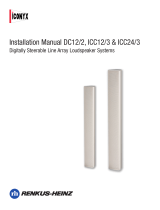 Renkus-Heinz iConyx DC12/2 Installation guide
Renkus-Heinz iConyx DC12/2 Installation guide
-
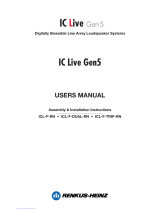 Renkus-Heinz ICL-F-TRIP-RN User manual
Renkus-Heinz ICL-F-TRIP-RN User manual
-
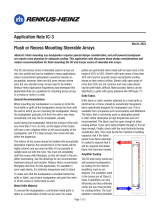 Renkus-Heinz Iconyx Compact User guide
Renkus-Heinz Iconyx Compact User guide
-
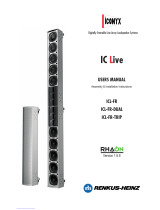 Renkus-Heinz Iconyx IC Live ICL-FR-DUAL User manual
Renkus-Heinz Iconyx IC Live ICL-FR-DUAL User manual
-
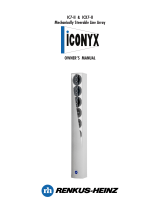 Renkus-Heinz Iconyx IC7-II Owner's manual
Renkus-Heinz Iconyx IC7-II Owner's manual
-
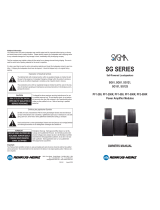 Renkus-Heinz PF2-500R Owner's manual
Renkus-Heinz PF2-500R Owner's manual
-
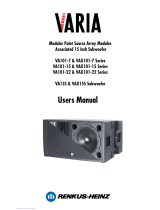 Renkus-Heinz VA101-22 Series User manual
Renkus-Heinz VA101-22 Series User manual
-
Renkus-Heinz CFX101LA User manual
-
Renkus-Heinz CFX101LA User manual
-
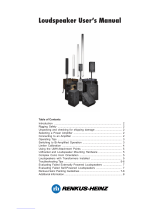 Renkus-Heinz Loudspeaker User manual
Renkus-Heinz Loudspeaker User manual
Other documents
-
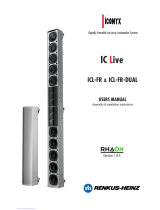 iConyx Iconyx IC Live ICL-FR User manual
iConyx Iconyx IC Live ICL-FR User manual
-
Texas Instruments TMS320TCI648x User manual
-
Texas Instruments Musical Instrument Amplifier TMS320C645X User manual
-
HEDD TYPE 05 Operating instructions
-
Martin Audio CDD-LIVE! Series User manual
-
Martin Audio CDD-LIVE 8 User Guides
-
Tannoy QFLEX 64-WP Quick start guide
-
Martin Audio CDD-LIVE 8 User Guides
-
LAB Gruppen D 200:4L Quick start guide
-
DYNACORD RCM-28 Owner's manual




























